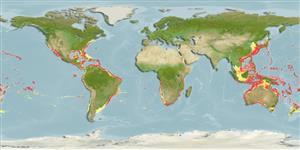>
Carangiformes (Jacks) >
Carangidae (Jacks and pompanos) > Caranginae
Etymology: Decapterus: Greek, deka = ten + Greek, pteron = wing, fin (Ref. 45335).
Environment: milieu / climate zone / depth range / distribution range
Ecologia
marino demersale; distribuzione batimetrica 7 - 550 m (Ref. 47377), usually 150 - 220 m (Ref. 5217). Subtropical; 45°N - 55°S, 102°E - 41°E
Pacific Ocean: Japan, Indonesia (Ref. 3197), Australia and the Hawaiian Islands Western Atlantic: Canada (Ref. 5951) to North Carolina, USA to Venezuela (Ref. 7251). Also found in Brazil (Ref. 47377) and in Argentina (Ref. 2806). Eastern Atlantic: St. Helena Island (Ref. 7097). Indian Ocean: off Kenya (Ref. 3287) to off East London, South Africa (Ref. 11228).
Length at first maturity / Size / Peso / Age
Maturity: Lm 30.0 range ? - ? cm
Max length : 50.0 cm TL maschio/sesso non determinato; (Ref. 3197); common length : 25.0 cm TL maschio/sesso non determinato; (Ref. 5217); peso massimo pubblicato: 560.00 g (Ref. 3277)
Spine dorsali (totale): 9; Raggi dorsali molli (totale): 30-34; Spine anali 3; Raggi anali molli: 24 - 26; Vertebre: 24. This species is distinguished by the following: posterodorsal margin of opercular membrane minutely serrated in adults; oral valve (membrane) at symphysis of upper jaw dusky or transparent; posterior end of upper jaw straight above, slightly concave and not strongly slanted anteroventrally; shoulder girdle (cleithrum) margin with 2 small papillae, the lower papilla larger; terminal dorsal- and anal-fin rays each consisting of a widely detached finlet; lateral line scales, in curved part 61-73, no scutes and straight part 4-12, followed by 30-40 scutes; total scales and scutes in lateral line (excluding scales on caudal fin) 103-118. Colour in life metallic blue to greenish above, silvery below; small black blotch on margin of opercle near upper edge; caudal fin bright red and tips of soft dorsal-fin rays tinged with red (Ref. 9894, 11228).
Adults occur in mid-water or near the bottom; also near the surface (Ref. 5217). They feed on smaller planktonic invertebrates, primarily copepods. Maximum depth recorded from Ref. 57551. Marketed fresh (Ref. 5217).
Paxton, J.R., D.F. Hoese, G.R. Allen and J.E. Hanley, 1989. Pisces. Petromyzontidae to Carangidae. Zoological Catalogue of Australia, Vol. 7. Australian Government Publishing Service, Canberra, 665 p. (Ref. 7300)
IUCN Red List Status (Ref. 130435)
Threat to humans
Harmless
Human uses
Pesca: scarso interesse commerciale; esca: usually
Strumenti
Special reports
Download XML
Fonti Internet
Estimates based on models
Preferred temperature (Ref.
123201): 12.1 - 22.4, mean 16.6 °C (based on 271 cells).
Phylogenetic diversity index (Ref.
82804): PD
50 = 0.5010 [Uniqueness, from 0.5 = low to 2.0 = high].
Bayesian length-weight: a=0.01259 (0.00858 - 0.01848), b=3.01 (2.89 - 3.13), in cm total length, based on LWR estimates for this species & Genus-body shape (Ref.
93245).
Trophic level (Ref.
69278): 3.2 ±0.32 se; based on food items.
Resilienza (Ref.
120179): Alto, tempo minimo di raddoppiamento della popolazione meno di 15 mesi (Fec=20,000-150,000).
Fishing Vulnerability (Ref.
59153): Moderate vulnerability (40 of 100).
